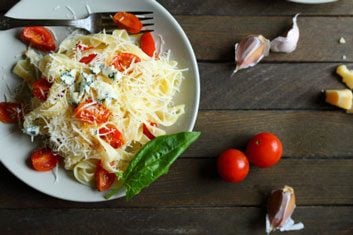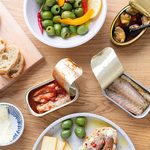Eating the Mediterranean way: Tips and recipes
Adopting the Mediterranean diet – and lifestyle – is a proven key to a long, happy life

Source: Best Health magazine, October 2014
I am in Parma, in the northern Italian region of Emilia-Romagna’a city of culture, steeped in history and proud tradition. Often referred to as ‘the heart of Italy’s Food Valley,’ the region is world-famous for such fine culinary contributions as Prosciutto di Parma (a.k.a. Parma ham), Parmigiano-Reggiano cheese, Aceto Balsamico (balsamic vinegar) from nearby Modena, and regional pastas.
On this summer morning, I’m in a cooking class at Academia Barilla’a centre owned by the Barilla Group, a Parma-based company that began in 1877. It is a global pasta producer, and is also dedicated to promoting Italian gastronomy through culinary teaching, chef training and local food tours. (Its gastronomic library has more than 11,000 books on food and culture dating back to the 16th century.)
A dozen of us don chef hats and aprons. As a trained chef and cookbook writer, I am always keen to learn a new trick or two. Armed with chef knives and hand-crank pasta rollers, we are soon busily preparing what will become our lunch. On today’s menu is Caponata’a Sicilian eggplant dish’and freshly baked rolls. A trio of pastas is also underway: tagliatelle (a long, flat noodle) with local extra virgin olive oil and vegetables; tortelli (a regional take on ravioli) filled with fresh ricotta and wilted Swiss chard; and hand-spun trofie (thin twisted pasta spirals) with green beans, potatoes and basil pesto. I volunteer to make the farro salad as I love this ancient grain, and there is also bass with black olives and fresh herbs baked in parchment paper.
A believer in cooking as a therapeutic tool, I find myself marvelling at how the combination of mixing, kneading, chopping and simmering is helping to better focus my thoughts, while also melting away stress and tension. It’s at once meditative and active, nourishing and thoughtful.
At lunch we sit, we savour, we sip (Lambrusco Marcello’a fruity sparkling red wine), and we share, both food and convivial conversation. It is served family-style’a Mediterranean custom of shared platters of food’meaning I can sample smaller portions. Everything for this meal is homemade, either by us or by local producers using fresh ingredients.
There is no rush to eat and get somewhere else; here in Parma, I’ve noticed most shops and businesses close for a leisurely, civilized two- to three-hour lunch break (shop hours are typically from 10 a.m. to 1 p.m., and 3:30 to 7:30 p.m.). After lunch, I feel satiated but not stuffed. Dinner, typically a smaller meal than lunch, will come much later, and in the form of leafy green salads and shared antipasto platters of locally crafted cheeses, fresh seafood and seasonal vegetables. Meanwhile, there is plenty of time in between to explore these breathtaking city streets by foot or bicycle.
Cooking fresh ingredients grown or sourced locally; taking the time to slow down, savour and enjoy food; along with being physically active: These are all basic elements of the Mediterranean diet and lifestyle.
Research suggests the health benefits of the Mediterranean diet are tremendous; they include a lowered risk for type 2 diabetes, heart disease, Parkinson’s and Alzheimer’s diseases; lowered cholesterol levels; less inflammation due to arthritis, resulting in better mobility; a lowered risk for stroke; and weight loss. It boosts energy levels, and improves mood and overall well-being.
The Mediterranean-style eating pattern is based on an abundance of vegetables and fruit, whole grains and nuts, legumes and rice, olives and olive oil, herbs and spices. To a lesser extent, the moderate consumption of fish and poultry, eggs and cheese, yogurt and milk, pasta and bread is observed and encouraged, while lean red meats are consumed only on occasion. For dessert, a piece of quality cheese with fresh fruit and nuts is customary, while small treats made with honey and fruit usually trump creamy, or refined white flour and sugar-laden, sweets. And often adults enjoy a glass of wine with meals.
This diet is typical of countries that border the Mediterranean Sea, including Italy, Croatia, Greece, France, Spain and Morocco, and also a handful of neighbouring countries (such as Portugal), although it varies a little in each. From an environmental standpoint, foods associated with the Mediterranean diet also tend to have a lesser impact on land use, water consumption and greenhouse gas emissions.
Weighing all of the Mediterranean diet’s advantages, plus my own experience preparing and enjoying the foods and trying the lifestyle, it’s got to be the world’s best diet.
Alison was inspired to create three Mediterranean recipes for Best Health readers; scroll down for the recipes.
2014 Research on the Mediterranean diet
• An Italian study (published online in the the American Society of Hematology’s journal Blood) ties the Med diet to lower levels of platelets and white blood cells, two markers of inflammation’which is linked to greater risk of heart attack and stroke.
• Research on 3,500 elderly adults at high risk for heart disease was published early this year in Annals of Internal Medicine. It found the Med diet lowered their risk of type 2 diabetes. And a review of 19 studies including some 162,000 people (Europeans and non-Europeans) over 5.5 years found the diet was associated with a 21 percent lower type 2 diabetes risk.
• A Harvard School of Public Health and Cambridge Health Alliance study found the Med diet was linked to a lower risk of cardiovascular disease in young working adults.
The Mediterranean mantra
• Quality over quantity: Eat a variety of fresh foods and in smaller portions. Eat slowly, and savour your food.
• Choose whole-grain foods, including oats, whole-wheat bread, brown rice and whole-grain pasta.
• Eat less red meat, and snack on raw, unsalted nuts, seeds and dried fruits, or dip raw vegetables in hummus.
• If possible, enjoy cultivating, growing and harvesting an edible garden outdoors, or growing pots of fresh herbs indoors in a sunny location. Swap what you grow in your garden with your neighbours.
• Eliminate as many processed and fast foods as possible.
• Eat sustainable and omega-3-rich fish such as salmon.
• Cook with family and friends, and sit down to eat together. Embrace cooking as a joy…not a chore.
Salmon with Herbed Farro
Nutty farro is an ancient grain akin to spelt; it’s high in fibre, and a good source of protein and iron. Get the recipe.
Spaghetti with Chicken, Feta & Olives
Whole-grain pasta is a good source of fibre, and olives are a Med diet staple that’s high in antioxidants. Get the recipe.
Honey-Roasted Ricotta with Figs and Grapes
This is ideal as an antipasto or an alternative to a rich dessert; serve it with flatbread crackers. It’s so fresh and flavourful you don’t need a large helping. Get the recipe.
This article originally appeared in the October 2014 issue of Best Health. Subscribe today to get the full Best Health experience’and never miss an issue!




